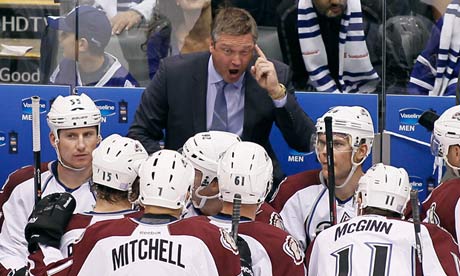
Through his first eleven games, Patrick Roy has his team atop the Central Division with a 10-1-0 record after having just beaten teams like the Penguins, Bruins, and Ducks. Although it's only late October, many publications and analysts are buying Colorado's stock right now by putting them near the top of all power rankings this week (LINK). Are the Avs, the team that finished with the second-to-last record, a legitimate force to be reckoned with this year? By digging deeper and using some "advanced stats", I'm here to tell you no.
If you aren't familiar with Corsi, you need to be. Here's how Hockey Prospectus defines the Corsi stat:
Corsi is
essentially a plus-minus statistic that measures shot
attempts. A player receives a plus for any shot attempt
(on net, missed, or blocked) that his team directs at
the opponent's net, and a minus for any shot attempt
against his own net. A proxy for possession.
Why people use Corsi is basically because it can be a pretty good indicator of future success. Another key stat that has become popular in the last few years is PDO (which stands for absolutely nothing). PDO is simply on-ice shooting percentage plus off-ice save percentage. PDO can measure "luckiness" because every shot either results in a save or goal, so PDO should heavily regress to 100%. If Team A has a PDO of 105%, the team should come back down to Earth. If Team B has a PDO of 95%, the team's luck should increase.
Okay, now that we got that out of the way, here's why the I'm not sold on the Avs yet.
Colorado's 47.7 5v5 CF% (Corsi for percentage) ranks in the bottom third of the league, 24th to be exact. The six teams below them? Panthers, Islanders, Flames, Oilers, Leafs (who somehow have a decent record), and Sabres. In their eleven games, in only four of them were they better Corsi-wise and in the Pittsburgh game, arguably their biggest win of the year, they had a dismal CF% of 35.3.
Individually, this year's first overall pick Nathan MacKinnon is really struggling, posting a 39.5 CF% despite being one of the team leaders for points. Landeskog, Parenteau, and Mitchell all have at least 7 points, but have negative Corsi so far this season.
Perhaps the biggest reason why the Avalanche aren't as good as their record is their PDO number. Right now, Colorado's 5v5 close PDO is 107.1 which is the second highest in the league. This means that their almost flawless record has been aided by lots of luck. Their success can't be sustained. It's not like they've been lucky, but have dominating play like say the Bruins. It's been the opposite.
They've been outplayed and have had luck on their side which means they're due for a tough stretch.
Colorado's 47.7 5v5 CF% (Corsi for percentage) ranks in the bottom third of the league, 24th to be exact. The six teams below them? Panthers, Islanders, Flames, Oilers, Leafs (who somehow have a decent record), and Sabres. In their eleven games, in only four of them were they better Corsi-wise and in the Pittsburgh game, arguably their biggest win of the year, they had a dismal CF% of 35.3.
Individually, this year's first overall pick Nathan MacKinnon is really struggling, posting a 39.5 CF% despite being one of the team leaders for points. Landeskog, Parenteau, and Mitchell all have at least 7 points, but have negative Corsi so far this season.
Perhaps the biggest reason why the Avalanche aren't as good as their record is their PDO number. Right now, Colorado's 5v5 close PDO is 107.1 which is the second highest in the league. This means that their almost flawless record has been aided by lots of luck. Their success can't be sustained. It's not like they've been lucky, but have dominating play like say the Bruins. It's been the opposite.
They've been outplayed and have had luck on their side which means they're due for a tough stretch.









